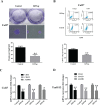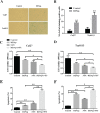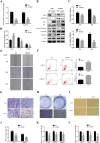The polycomb group protein EZH2 is a novel therapeutic target in tongue cancer
- PMID: 24345883
- PMCID: PMC3926847
- DOI: 10.18632/oncotarget.1503
The polycomb group protein EZH2 is a novel therapeutic target in tongue cancer
Abstract
EZH2, a core member of the Polycomb Repressor Complex 2 (PRC2), mediates transcriptional silencing by catalyzing the trimethylation of histone 3 lysine 27 (H3K27), which plays key roles in cancer initiation and progression. Here, we investigated the expression pattern and biological roles of EZH2 in tongue tumorigenesis by loss-of-function assays using small interference RNA and EZH2 inhibitor DZNep. Also we determined the therapeutic efficiency of DZNep against tongue cancer in vivo. We found that aberrantly overexpressed EZH2 was associated with pathological grade, cervical nodes metastasis and Ki-67 expression in tongue cancers. Elevated EZH2 correlated with shorter overall survival and showed significant and independent prognostic importance in patients with tongue cancer. Both genetic and pharmacological depletion of EZH2 inhibited cell proliferation, migration, invasion and colony formation and decreased CD44+ subpopulation probably in part through modulating p16, p21 and E-caherin. Moreover, DZNep enhanced the anticancer effects of 5-Fluorouracil. Furthermore, intratumoral EZH2 inhibition induced by DZNep intraperitoneal administration significantly attenuated tumor growth in a tongue cancer xenograft model. Taken together, our results indicate that EZH2 serves as a key driver with multiple oncogenic functions during tongue tumorigenesis and a new biomarker for tongue cancer diagnosis and prognostic prediction. These findings open up possibilities for therapeutic intervention against EZH2 in tongue cancer.
Figures







References
-
- Ferlay J, Shin HR, Bray F, Forman D, Mathers C, Parkin DM. Estimates of worldwide burden of cancer in 2008: GLOBOCAN 2008. International journal of cancer Journal international du cancer. 2010;127(12):2893–2917. - PubMed
-
- Scully C, Bagan JV. Recent advances in oral oncology 2008; squamous cell carcinoma imaging, treatment, prognostication and treatment outcomes. Oral oncology. 2009;45(6):e25–30. - PubMed
-
- Haddad RI, Shin DM. Recent advances in head and neck cancer. The New England journal of medicine. 2008;359(11):1143–1154. - PubMed
-
- Simon JA, Kingston RE. Mechanisms of polycomb gene silencing: knowns and unknowns. Nature reviews Molecular cell biology. 2009;10(10):697–708. - PubMed
Publication types
MeSH terms
Substances
LinkOut - more resources
Full Text Sources
Other Literature Sources
Miscellaneous

